Updated: 20-Oct-2020
Known as "NPO Energomash".
-This company has collected all the previous history of the Soviet Union in the field of rocket engines, in such a way that it fixes its roots on Glushko, a pioneer, and reaches until today, with the current ISS and future Mars projects, etc.
-In May 1929 a group is organized under the direction of Valentin Glushko for the development of rocket engines, known as GDL (Gas Dynamic Laboratory), in Leningrad.
-It joins the USSR rocket-engine production with that of Russia including engines started by Gird and Gdl, in addition to Glushko. See chapter of Glushko.

"NPO Energomash logo"

"Valentin Glushko”
-The first tested engine was the ORM, the beginning of a very long series.
-This small engine only gave 6 Kgs. of thrust with nitrogen oxide and gasoline.
-Like the ORM-1 with 20 Kgf of thrust, running on oxygen and gasoline although toluol was also tested, the same as the ORM-2 from 1931.
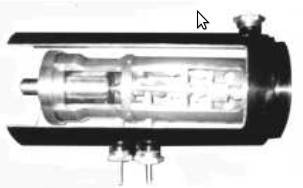
"ORM-1"
-The ORM (written OPM in Cyrillic) were experimental engines with which most diverse fuels were tested:
-The ORM-2 followed with toluene (toluol).
-The ORM-3 was tested with tetraborane.
-The ORM-4, -5 and -8 run on liquid air, oxygen, nitric acid and as fuel, gasoline, benzol and toluene. Year 1932.
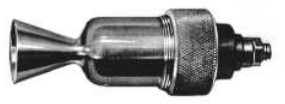
"First designs"
-The ORM-6 and -7 were not tested, they remained in experimental stage.
-The ORM-9 was tested with liquid oxygen and gasoline, although in the end it also used kerosene.
-They were followed in the list by the -10, -11, and so on. Until the -22 they were very similar.
-Between the -23 and the -26, they started to use nitric acid and tetra nitric acid as oxidants until the -52. Getting to the -39 when we get thrust data of 100 Kgf. And 150 Kgf for the -40.
-In 1933, from the -44 to the -46 with 250 Kgf. Reaching the -52 with less than 300 Kgf.
-In 1934 they started to built the -53 and continuing until the -65 in 1936. The latter seemed interesting and had thrust control. For example 175 Kgf. max, 155 Kgf nominal, and 50 Kgf minimum.
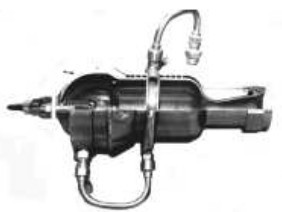
"ORM-65"
-All tests included electric or pyrotechnic ignition, centrifugal injectors, or double wall nozzle and spiral circulation to cool it, including the combustion chamber. This can be seen in the above figure.
-Actually, the first useful engine was this ORM-65, which was already installed on gliders like the RP-318 or was tested on the winged rockets of another designer, S. Korolev.
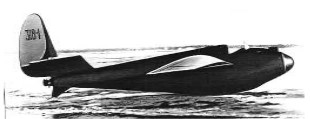
"318 glider"

"Winged rockets, with ORM-50 and Korolev's"
-The ORM line would end with the -102 in 1937. It is interesting that the -101 used tetranitromethane with kerosene.
-As well as the engines, gas generators such as the GG-1 were developed for accessory use in basic engines.
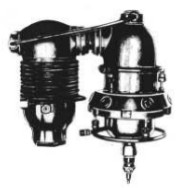
"Generator accessory"
-In 1933 the GDL changed its structure and moved from Leningrad to Moscow being based on the previous group it was called MosGIRD.
-Between 1939 and 1940 they joined the 4th special department of NKVD (Kuznetsov) in Tushino which was the GAZ-82.
-During WWII or Great Patriotic War as it is denominated in Russia, this OKB of study moved to Kazan, to the GAZ-16.
-During this war the rocket engines RD-1 with 300 Kgf, the RD-2 with 600 Kgf, the RD-3 with 900 Kgf and the RD-4 with 2,000 Kgf appeared and were followed by others. They were installed on conventional fighters for interception, combat, climbing, etc.
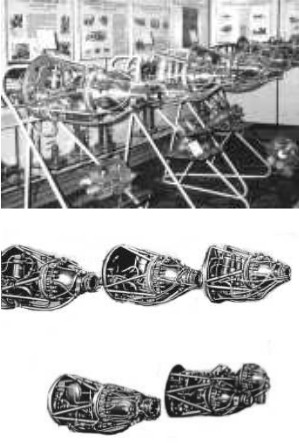
"RD-1, 2, 3, 4 at Museum"
-In 1946, it is reorganized as OKB-456 to experiment with more powerful liquid fuel rockets. The team is reinforced with integrated German technicians.
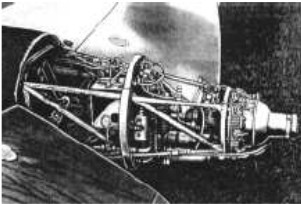
"RD- on a fighter tail"
-Not only the German technicians arrived, but there was also confiscated material and documentation. So it is not surprising that the first Russian rockets (like the American ones) were based on the V-2 (A-4).
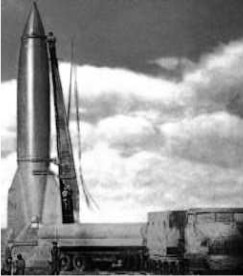
"German R-1 -V-2- rocket"
-The used engine was almost an identical copy of the German one, at least in its outward appearance. It was called RD-100 and according to the proclamation it was built with domestic materials and domestic technology. It gave 26 ton of thrust at sea level.
-A little bit more powerful was the RD-101 for the R-2 rocket, and also the RD-103 for the R-5M missile. All were developments from the RD-100 engine and the R-1 missile.
-It is from this moment when they begin to conceive new projects in search of high powers.
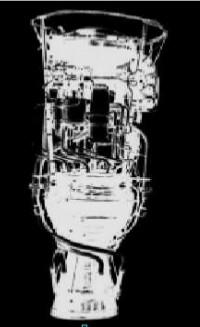
“RD-100” (PiP)
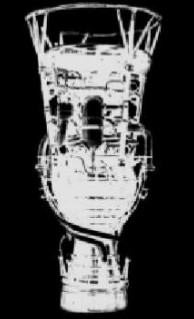
“RD-101” (PiP)

“RD-103”
-The decision to "break" with German projects and start with their own began with an experimentation chamber called AD-140 that gave around 7 tons of thrust, in 1949, coming to the conviction that the shape of a cylindrical chamber was more optimal.
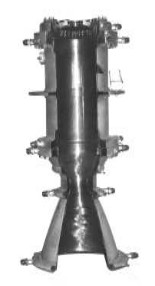
"AD-140 chamber"
-The arrangement of the injectors for the two propellants was improved so that the combustion was complete. The double cooling wall made it possible to use more ordinary material - such as bronze - to withstand the high temperatures inside the chamber.
-The RD-105, operating between 1955 and 1964, like the RD-106 (1953-1966) it used LOX and kerosene.

“RD-107”
-In 1957 the USSR astonished the world with the launch of the first Earth satellite, it was the Sputnik and it was placed in orbit with the Vostok launch vehicle that carried RD-107 and RD-108 engines. There were also chambers called "steering" to stay in orbit.
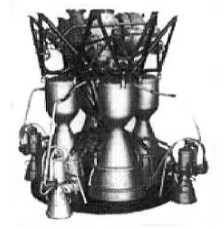
“RD-108”
-The fuel was LOX / Kerosene. With modernized variants more satellites were placed around Earth and around the Moon, investigating space and the solar system.
-They proved to be very reliable engines and allowed the great advance of this country on this matter.
-So we saw them on the Sputnik, Luna, Vostock, Voskhod / Molnia and Soyuz rockets.
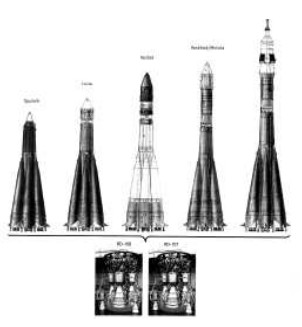
"First Russian operational rockets (Zemi-orka family: R-7, etc.)"
-The RD-109 that was used between 1958 and 1960 consumed Lox and UDMH. The RD-110 proved to be a much earlier engine (1947-1951). Many of these engines were destined to the ballistic missiles at that time.

"R-12, 11K63, R-14, R-9, R-16, R-36, R-360p6 and R-36M"
-Between 1959 and 1962, with the same fuels, the RD-111 was developed. The steering control was not entrusted to other small engines but the main ones could be moved being mounted in a kind of cradle (gimbal). They delivered 144 and 166 tons of thrust.
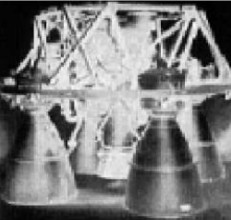
“RD-111” (PiP=mw)
-The RD-111 was mounted on the R-9 ballistic missile. The RD-112 engine on the R-20, just as the RD-113.
-The rocket engines, better said "engine clusters" forming the RD-114 and RD-115 sets were the ones that were mounted on the H-1 missiles.
-In 1970, the RD-116 was an engine that continued to use oxygen and kerosene. The RD-117 for the Molnia used oxygen and T-1, just as the RD-118.
-The RD-119 was used by many rockets of the Cosmos series in their upper stage. The RD-214 was used on the main stage.

"RD-119"
-The RD-120 was used between 1976 and 1986. It delivered 85 tons of thrust in vacuum.
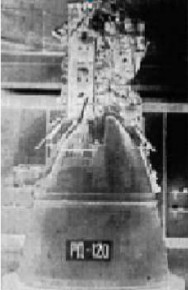
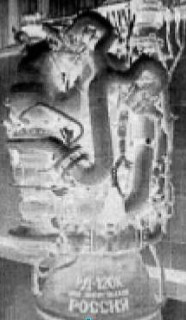
“RD-120 and RD-120K” (P¡P=mw)
-From each type of engine there were variants as we can see in the above RD-120 and its K version. They were intended for the Zenith.
-In this edition, we add RD-120 versions used by Sea-Launch, an international cooperation.

"RD-120"

"Launch of the Sea-Launch"
-As from the RD-121 most engines were mounted on the RH, 11K55, 11K77, missiles. Some of them used hydrogen and Sintin with oxygen. During the 1970's and 1980's.
-The RD-120 is also used in medium-type rockets, such as the Zenith. It uses hydrogen and oxygen.
-It is considered the predecessor of the RD-170 and RD-171. Built by NPO Yuzhnoye in Ukraina, although most of the materials come from Russia.

“RD-161”
-The RD-161 has a single chamber using oxygen and hydrogen. It was developed towards 1988 for higher stages of the modified Soyuz.

"Two RD-704 adapted to the Buran"
-Very important has been the RD-170 and its derivative RD-171. As we will see some Russian engines are manufactured under license in other countries like USA! (see).
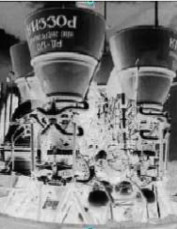
“RD-170-171” (PiP=mw)
-The RD-172 was still based on the RD-171. The "Sea Launch" of the western-eastern joint program for launching from a marine platform uses the RD-120 and RD-171. The RD-170 gave a thrust of 750 tons. at sea level and 800 tons in vacuum.

"Energia and Buran vehicles"
-The RD-180 only has two combustion chambers and in 1996 it won the competition to modernize the American Atlas II from Lockheed Martin. P & W made them
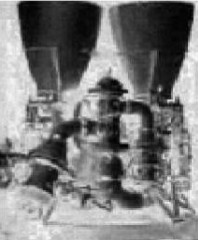
“RD-180” (PiP=mw)
-The RD-191 was perhaps the last to operate with liquid oxygen and kerosene, giving 191 tons of thrust at sea level pressure and 212 tons in vacuum.

“RD-191”
-The reason for the change was because liquid oxygen needed cryogenic facilities and was not storable like nitric acid or nitrogen tetroxide (HNO3), the fuel was UDMH.
-That is how the RD-210 up to the RD-275, at least, are. (remember that RD-1, 2, 3 and 200 used this type of fuels).
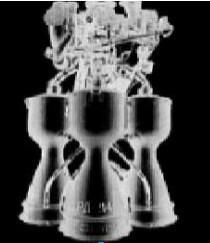
“RD-214” (PiP=mw)
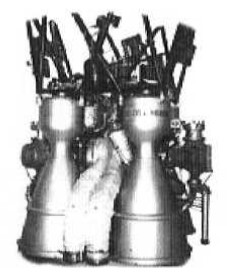
“RD-216”
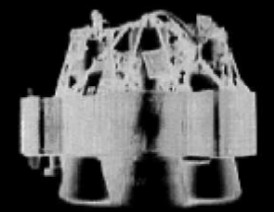
“RD-218” (PiP=mw)
-The RD-214 gave 65 tons of thrust at sea level and 75 in vacuum.
-The RD-216, 150 tons at sea level and 175 tons in vacuum. On the Comos 3M.
-The RD-218 gave 226 tons at sea level and 266 in vacuum.
-From the RD-219 we only have the thrust in vacuum, 95 tons.
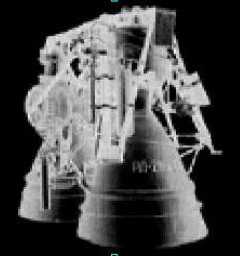
“RD-219” (PiP=mw)
-The series continues with the RD-220, -221, -222 and -223 for the RH H1 missiles.
-The RD-224 was mounted on the R-26, and it used Nitric acid and "Unsymetrical DiMethyl Hydrazine". (N2O4 / UDMH). The RD-224 was a cluster of RD-225.
-We come to the RD-250 grouped series resulting in the RD-251 and RD-261. The RD-251 was for the R-36 missile.
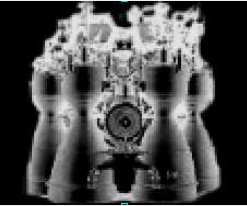
“RD-251” (PiP=mw)
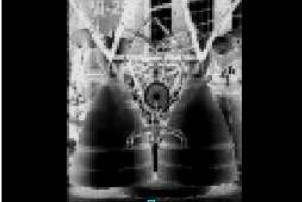
“RD-252” (PiP)
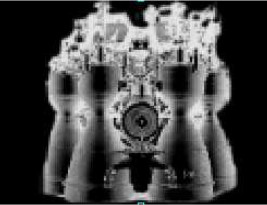
“RD-252 bis” (PiP)
-The RD-252 gave 96 tons in vacuum and also motorizes the R-36.
-The RD-253 is already an important one, for propelling the Proton rockets, which carries six of them.

"Protón"
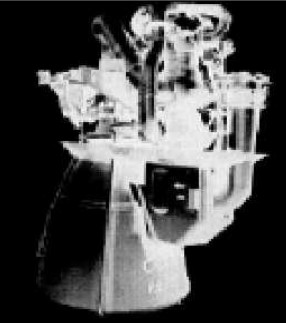
“RD-253” (PiP=mw)
-The Proton has been famous for launching the Luna, Venera, Mars spacecraft, as well as the Salyut and Mir orbital stations. The RD-253 has been replaced by the more modern RD-275.
-To avoid fatigue, we do small "jumps" over the least known references, to get to the RD-261 and RD-262 of which the Cyclone-2 vehicle had three RD-261 engines in the main stage and one RD- 262 in the second stage.
-The Cyclone-3 had three RD-260 rocket engines in stage 1 and one RD-262 engine in stage 2.
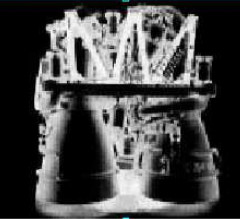
“RD-264” (PiP=mw)
-The RD-264 engines were installed on the "Dnepr-1" having 4 of them. The tendency to use "storable" fuels such as nitric acid and UDMH for its practicality was also maintained with the RD-268 et seq.
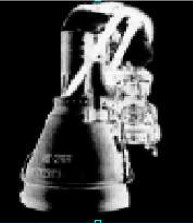
“RD-268” (PiP=mw)
-The RD-268, a single chamber engine, gave 117 tons of thrust at sea level and 126 in vacuum. Much more powerful was the RD-270 with 640/684 tons according to both circumstances.

“RD-270” (PiP=mw)
-The RD-270 used Nitrogen Tetroxide and UDMH. The RD-273 gave 117/126 Tons. The RD-274 delivered 468/504 Tons.
-As it was said, the RD-275 replaces the Proton K engine, giving 162/178 Tons. The RD-280 is known about, and appears to be small.
-If we have been good observers, we have noticed that the RD-"100" series use oxygen (LOX) and fuels like kerosene mainly. The "200" series are engines with long-term storage fuels based on nitric acid and nitrogen tetroxide as oxidizers.
-Now the RD -"300" series are engines with the most different fuels. For example the RD-350 consumed hydrogen.

“RD-301” (PiP)
-The RD-301 (with F2 / NH3), RD-302, RD-303 and RD-350 are known.
-The RD-401 and RD-404 series run on nuclear fuel (U-235) and hydrogen.
-In the RD- "500" other fuels appear, pentaborane, beryllium, etc. From this series the RD-502, 503, -510, -511, -512, -513 and -550 are known.
-An RD-600 used U-235 and hydrogen with lithium. Giving 600 tons of thrust in vacuum.

"RD-701 and RD-704" (PiP)
-The RD-701 and RD-704 have two operating modes. The RD-701 delivered 400 tons of thrust in Mode-1 using O2/H2 + Kerosene and in Mode-2 it gave 162 tons running only on O2/H2.
-The RD-704 uses the same fuels in both modes but with exactly half the powers.
-Not to say that the RD-denominations are official because the Energomash factory has its own internal regime, for example:
-The RD-107 is 8D74.
-The RD-107MM is 8D728.
-The RD-252 is 8D724.
-The RD-270 is 8D420.
-The RD-301 is 11D14.
-The RD-510 is 11D217. Etc etc.
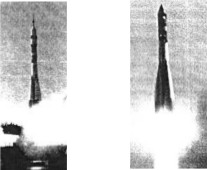
"Takeoff and Exit"
From Appendix 9: After a new review of information brought from an Air Show, we add the following illustrations of engines that are either new or appear in negative in the main text.

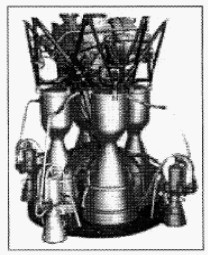
“New photos for the RD-107 and RD-108”
-The 4-engine cluster that forms the RD-107 was started between 1954 and 1957 and was used in the first Vostok. This group includes two small vernier engines for course control. All powered by a single turbo pump.
-Used for the first Sputnik I satellite and for the first Gagarin flight.

“RD-111”
-An engine that appeared in 1962 with four chambers in cluster, used profusely in the first stage of the Cosmos rockets.

“RD-119 from 1963”
-For the second stage of the Cosmos', the RD-119 was used. The design began to be studied around 1958. It had a single chamber and four steering control nozzles, using LOX and UDMH (asymmetric Dimethyl hydrazine).

“RD-120”
-It was made for the second stage of the Zenith vehicle. It is also built by NPO Yuzhnoye, in Ukraina, although with the majority of components coming from Russia.
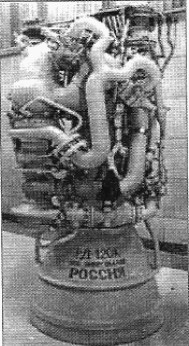
“RD-120-K”

“RD-161”
-An engine with a single chamber using LOX and kerosene, from the year 1988. It has vernier control in two directions.
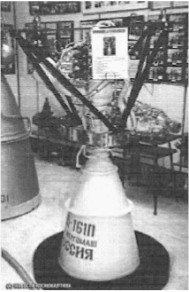
“RD-161”
-This engine is being modified to use "Atsetam" fuel, in Russian it is "acetylene and ammonia" at 25% and 75% respectively. Classic engines based on kerosene and liquid oxygen are called "kerolox" in Russia.
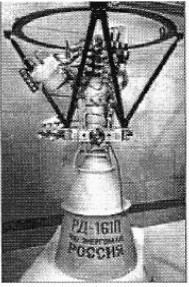
“RD-161P derived from RD-161”
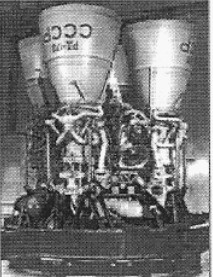
"RD-170 / RD-171"
-The RD-170 cluster has 4 chambers, and is used in Energia vehicles. The RD-171 variant was mounted on the Zeniths.

“RD-170”
-The RD-171M is based on the RD-170. The RD-171M is considered one of the most powerful rocket engines that has been in service surpassing the F-1 for the Saturn V.
-They delivered 740 tons and 694 tons of thrust respectively. However, the new RD-175 will reach 1000 tons.

“RD-171-M”
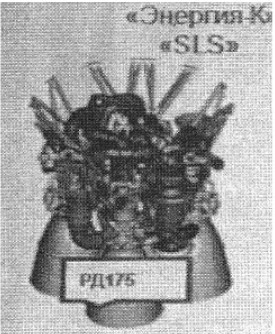
“RD-175”
-The RD-180 is derived from the previous RD-170/RD-171, closed cycle, and with two chambers and two nozzles.
-The RD-180 engines are built in the USA for the Atlas 3 and 5.
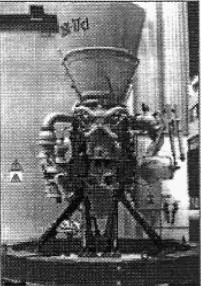
“RD-180”
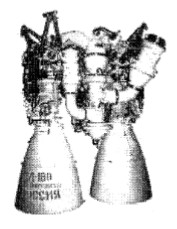
“RD-180 twin assembly”
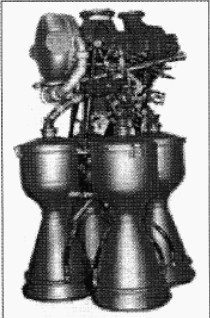
“RD-214”
-Completed in 1957, the RD-214 was used in the first stage of the Cosmos prototype. It had four chambers and had no gimballing or vernier control.
-Despite the results and the Russian philosophy, it is no longer in production.

“RD-216”
-In 1960, the work on the RD-216 was started, and this engine was operational in 1964.

“RD-218”
-The RD-218 was made between 1958 and 1961, but to be used in strategic missiles, that is, military. It is not known if it is still in use although it is no longer in production.
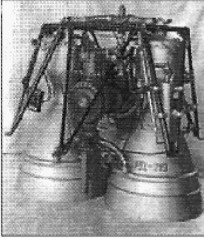
“RD-219”
-For the Proton, the RD-253 was used. Perhaps the most powerful rocket engine with a single chamber that has been built by NPO Energomash. It uses nitrogen tetroxide and UDMH.
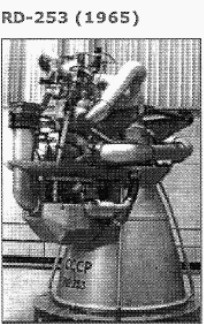
“RD-253”
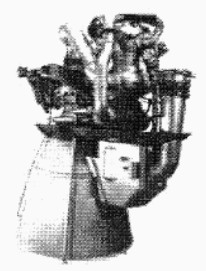
"Another view of the RD-253"
-This engine was highly reliable, it had been operated without failures until 1969. The RD-275 (14D14) was the result of an RD-253 modification (between 1987 and 1993) with almost 8% more thrust.
-A variant was the RD-275M (14D14M) that was put into service around 2005 on the Proton M.
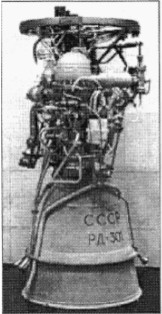
“RD-301”
-The RD-301 was built to run on fluorine/ammonia, although it has not been operational, as it is known.
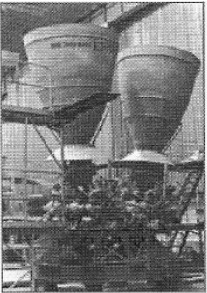
“RD-700”
-View the main text to learn more about this atypical tri-propellant fuel engine in two stages.
-The following may also work: There is the launch mode, in which it operates with liquid oxygen, liquid hydrogen and kerosene.
-In the second mode, in the atmospheric trans stage, it only consumes liquid hydrogen and liquid oxygen.
-It had two more variants, the RD-701 with two chambers and the single-chamber RD-704.
-Part of this information is from the Buran-energy website, written by Vassil Petrovich (PiP).
NOTE = More info at <astronautix.com> .
-We collected a photograph with an assortment of small maneuver rocket engines.

"7 small Energomash engines"
From Appendix 10: When we mention this brand, we have Glushko, GDL, GIRD etc behind it (see main text).

“German project number 4”
-The Germans made engine projects that were different from the ones we know from the V-2. To the Russians, project Number 4 served as an inspiration for the RD-110.

"And the Russian development as RD-110"

"The RD-110 as a final result"
-Very soon this engine was replaced by its own developments around 1951.
-The German projects were dropped in favor for those that showed better performance because of their cylindrical combustion chambers.

“RD-105 with turbo pumps”
-The length of the combustion chamber was due to a problem of stabilization and oscillations that forced this elongated shape.
-The RD-106 was somewhat similar to the RD-105 but with a shorter chamber. The installation of ducts and the pump's turbo upon it, still makes you remember some of the German designs.
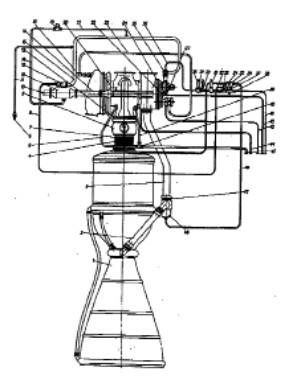
"RD-106" (From the Instruction Manual)
From Appendix 12: We access the classification of Russian rocket engines through their initial numbering:
-RD-1xx = Liquid oxygen and kerosene,
-RD-2xx = Nitric acid and Tetroxide
-RD-3xx = Fluorine
-RD-4xx = Nuclear
-RD-5xx = Hydrogen and Peroxide
-RD-6xx = Nuclear
-RD-7xx = Tripropellants
-The RD-107 and RD-108 belong to the same family that was used on the R-7 missiles from 1954 and later on the “Vostok”, “Voshod”, Molniya, “Soyuz”. From 1957 they became famous for being the first successful launch of an intercontinental missile, putting the first satellite into orbit (Sputnik), and also the first man in space.
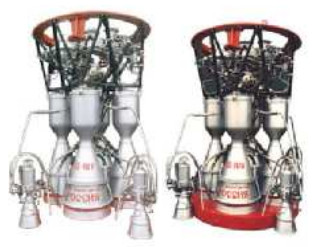
"RD107 and RD-108"
-The RD-120 was installed in the second stage of the “Zenit” from 1976.
-For the first stage of the “Zenit”, RD-171Ms were installed -and also in the “Energia” series -. It is reusable, at least more than 5 times and it is also controllable. Lately it is used on the "Sea Launch".
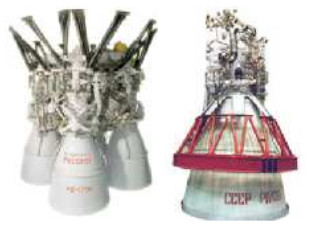
"RD-171M and RD-120"
-The RD-180 was designed from the year 1996 on the basis of the 107 and 108, so it started with well-proven engines. The success has been that Lockheed-Martin in the US uses them in their Atlases.
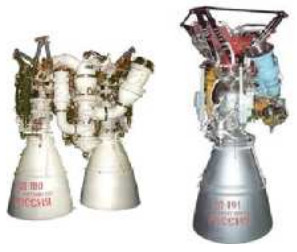
"RD-180 and RD-191"
-The RD-191, has been destined mainly to the "Angara". This was a 1998 design on well proven 170 and 171 engines.
-The RD-253 began its design in 1961 although it did not make its first launch until 1965 on a "Proton".
It has been one of the most reliable engines and has also been installed on the "Luna", "Venera" and "Mars". It served to put the "Mir", "Salyut" and parts of the ISS into orbit.
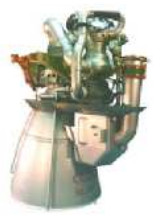
“RD-253”
-Currently, serial production continues in the city of Perm, at the Kamsky subsidiary of NPO-Energomash.
Engines of ENERGOMASH
Model: Camara AD-140 cilindrica
Arquitecture: Rocket engine
Chambers:
Fuels:
Feed System:
Ignition:
Thrust: 7000 Kgf
Weight:
Model: ORM
Arquitecture: Rocket engine
Chambers:
Fuels: nitrogen oxide and gasoline
Feed System:
Ignition:
Thrust: 6 Kgf
Weight:
Model: ORM-1
Arquitecture: Rocket engine
Chambers: Single chamber
Fuels: oxygen and gasoline
Feed System:
Ignition:
Thrust: 20 Kgf
Weight:
toluol was also tested

"Energomash, ORM-1"
Model: ORM-10 --> 102)
Arquitecture: Rocket engine
Chambers:
Fuels:
Feed System:
Ignition:
Thrust:
Weight:
Until the -22 they were very similar.
Between the -23 and the -26, they started to use nitric acid and tetra nitric acid as oxidants until the -52. Getting to the -39 with 100 Kgf. And 150 Kgf for the -40.
The -44 to the -46 with 250 Kgf. Reaching the -52 with less than 300 Kgf.
The -65 had thrust control. For example 175 Kgf. max, 155 Kgf nominal, and 50 Kgf minimum.
The -101 used tetranitromethane with kerosene.
The ORM line would end with the -102 in 1937.

"Energomash, ORM-65"
Model: ORM-2
Arquitecture: Rocket engine
Chambers: Single chamber
Fuels: oxygen and gasoline
Feed System:
Ignition:
Thrust: 20 Kgf
Weight:
Toluol was also tested
Model: ORM-3
Arquitecture: Rocket engine
Chambers: Single chamber
Fuels: oxygen and gasoline
Feed System:
Ignition:
Thrust:
Weight:
It was also tested with tetraborane.
Model: ORM-4
Arquitecture: Rocket engine
Chambers: Single chamber
Fuels: liquid air, oxygen, nitric acid and as fuel, gasoline, benzol and toluene.
Feed System:
Ignition:
Thrust:
Weight:
Model: ORM-5
Arquitecture: Rocket engine
Chambers: Single chamber
Fuels: liquid air, oxygen, nitric acid and as fuel, gasoline, benzol and toluene.
Feed System:
Ignition:
Thrust:
Weight:
Model: ORM-6
Arquitecture: Rocket engine
Chambers:
Fuels:
Feed System:
Ignition:
Thrust:
Weight:
The ORM-6 was not tested, it remained in experimental stage.
Model: ORM-7
Arquitecture: Rocket engine
Chambers:
Fuels:
Feed System:
Ignition:
Thrust:
Weight:
The ORM-7 was not tested, it remained in experimental stage.
Model: ORM-8
Arquitecture: Rocket engine
Chambers: Single chamber
Fuels: liquid air, oxygen, nitric acid and as fuel, gasoline, benzol and toluene.
Feed System:
Ignition:
Thrust:
Weight:
Model: ORM-9
Arquitecture: Rocket engine
Chambers: Single chamber
Fuels: liquid oxygen and gasoline
Feed System:
Ignition:
Thrust:
Weight:
In the end it also used kerosene.
Model: RD-1
Arquitecture: Rocket engine
Chambers:
Fuels:
Feed System:
Ignition:
Thrust: 300 Kgf
Weight:
Model: RD-100
Arquitecture: Rocket engine
Chambers:
Fuels:
Feed System:
Ignition:
Thrust: 26000 Kgf
Weight:
Copy of the German A-4.
Model: RD-101
Arquitecture: Rocket engine
Chambers:
Fuels:
Feed System:
Ignition:
Thrust:
Weight:
Model: RD-102
Arquitecture: Rocket engine
Chambers:
Fuels:
Feed System:
Ignition:
Thrust:
Weight:
Model: RD-103
Arquitecture: Rocket engine
Chambers:
Fuels:
Feed System:
Ignition:
Thrust:
Weight:

"Energomash, RD-103"
Model: RD-104
Arquitecture: Rocket engine
Chambers:
Fuels:
Feed System:
Ignition:
Thrust:
Weight:
Model: RD-105
Arquitecture: Rocket engine
Chambers:
Fuels: LOX and kerosene
Feed System:
Ignition:
Thrust:
Weight:

"Energomash, RD-105 with turbo pumps"
Model: RD-106
Arquitecture: Rocket engine
Chambers: Single chamber
Fuels: LOX and kerosene
Feed System:
Ignition:
Thrust:
Weight:
The RD-106 was somewhat similar to the RD-105 but with a shorter chamber.

"Energomash, RD-106 (From the instruction manual)"
Model: RD-107 (8D74), -A
Arquitecture: Rocket engine
Chambers:
Fuels:
Feed System:
Ignition:
Thrust:
Weight:
Cluster of four engines.
This group includes two small vernier engines for course control.

"Energomash, RD-107"
Model: RD-107MM (8D728)
Arquitecture: Rocket engine
Chambers:
Fuels:
Feed System:
Ignition:
Thrust:
Weight:
Model: RD-108, -A
Arquitecture: Rocket engine
Chambers:
Fuels:
Feed System:
Ignition:
Thrust:
Weight:

"Energomash, RD-108"
Model: RD-109
Arquitecture: Rocket engine
Chambers:
Fuels: Lox and UDMH
Feed System:
Ignition:
Thrust:
Weight:
Model: RD-110
Arquitecture: Rocket engine
Chambers:
Fuels:
Feed System:
Ignition:
Thrust:
Weight:

"Energomash, The RD-110 final result"
Model: RD-111
Arquitecture: Rocket engine
Chambers:
Fuels: Lox and UDMH
Feed System:
Ignition:
Thrust: 144000 / 166000 Kgf
Weight:

"Energomash, RD-111 cluster"
Model: RD-112
Arquitecture: Rocket engine
Chambers:
Fuels:
Feed System:
Ignition:
Thrust:
Weight:
Model: RD-113
Arquitecture: Rocket engine
Chambers:
Fuels:
Feed System:
Ignition:
Thrust:
Weight:
Model: RD-114
Arquitecture: Rocket engine
Chambers:
Fuels:
Feed System:
Ignition:
Thrust:
Weight:
Cluster
Model: RD-115
Arquitecture: Rocket engine
Chambers:
Fuels:
Feed System:
Ignition:
Thrust:
Weight:
Cluster
Model: RD-116
Arquitecture: Rocket engine
Chambers:
Fuels: Oxygen and kerosene
Feed System:
Ignition:
Thrust:
Weight:
Model: RD-117
Arquitecture: Rocket engine
Chambers:
Fuels: Oxygen and T-1
Feed System:
Ignition:
Thrust:
Weight:
Model: RD-118
Arquitecture: Rocket engine
Chambers:
Fuels: Oxygen and T-1
Feed System:
Ignition:
Thrust:
Weight:
Model: RD-119
Arquitecture: Rocket engine
Chambers: Single chamber
Fuels: Lox and UDMH
Feed System:
Ignition:
Thrust:
Weight:
It had four steering control nozzles

"Energomash, RD-119 from 1963"
Model: RD-120, -120K
Arquitecture: Rocket engine
Chambers:
Fuels:
Feed System:
Ignition:
Thrust: 85000 Kgf
Weight:

"Energomash, RD-120 K, fig. 2"
Model: RD-121
Arquitecture: Rocket engine
Chambers:
Fuels:
Feed System:
Ignition:
Thrust:
Weight:
Model: RD-161, -P
Arquitecture: Rocket engine
Chambers: Single chamber
Fuels: LOX and kerosene
Feed System:
Ignition:
Thrust:
Weight:
This engine is being modified to use "Atsetam" fuel, in Russian it is "acetylene and ammonia" at 25% and 75% respectively.

"Energomash, RD-161, fig.2"
Model: RD-170
Arquitecture: Rocket engine
Chambers: 4 chambers
Fuels:
Feed System:
Ignition:
Thrust: 750000 Kgf
Weight:

"Energomash, RD-170"
Model: RD-171, -M
Arquitecture: Rocket engine
Chambers: 4 chambers
Fuels:
Feed System:
Ignition:
Thrust: 694000 Kgf
Weight:
Model: RD-172
Arquitecture: Rocket engine
Chambers:
Fuels:
Feed System:
Ignition:
Thrust:
Weight:
Model: RD-175
Arquitecture: Rocket engine
Chambers:
Fuels:
Feed System:
Ignition:
Thrust: 1000000 Kgf
Weight:

"Energomash, RD-175"
Model: RD-180
Arquitecture: Rocket engine
Chambers: 2 chambers
Fuels:
Feed System:
Ignition:
Thrust:
Weight:

"Energomash, RD-180"
Model: RD-183
Arquitecture: Rocket engine
Chambers:
Fuels:
Feed System:
Ignition:
Thrust:
Weight:
Model: RD-191
Arquitecture: Rocket engine
Chambers:
Fuels: LOX and kerosene
Feed System:
Ignition:
Thrust: 191000 / 212000 Kgf
Weight:

"Energomash, RD-191"
Model: RD-2
Arquitecture: Rocket engine
Chambers:
Fuels:
Feed System:
Ignition:
Thrust: 600 Kgf
Weight:
Model: RD-210
Arquitecture: Rocket engine
Chambers:
Fuels:
Feed System:
Ignition:
Thrust:
Weight:
Model: RD-214
Arquitecture: Rocket engine
Chambers:
Fuels:
Feed System:
Ignition:
Thrust: 65000 / 75000 Kgf
Weight:

"Energomash, RD-214"
Model: RD-216
Arquitecture: Rocket engine
Chambers:
Fuels:
Feed System:
Ignition:
Thrust: 150000 / 175000 Kgf
Weight:

"Energomash, RD-216"
Model: RD-218
Arquitecture: Rocket engine
Chambers:
Fuels:
Feed System:
Ignition:
Thrust: 226000 / 266000 Kgf
Weight:

"Energomash, RD-218"
Model: RD-219
Arquitecture: Rocket engine
Chambers:
Fuels:
Feed System:
Ignition:
Thrust: 95000 Vac. Kgf
Weight:

"Energomash, RD-219"
Model: RD-220
Arquitecture: Rocket engine
Chambers:
Fuels:
Feed System:
Ignition:
Thrust:
Weight:
Model: RD-221
Arquitecture: Rocket engine
Chambers:
Fuels:
Feed System:
Ignition:
Thrust:
Weight:
Model: RD-222
Arquitecture: Rocket engine
Chambers:
Fuels:
Feed System:
Ignition:
Thrust:
Weight:
Model: RD-223
Arquitecture: Rocket engine
Chambers:
Fuels:
Feed System:
Ignition:
Thrust:
Weight:
Model: RD-224
Arquitecture: Rocket engine
Chambers:
Fuels: N2O4 / UDMH
Feed System:
Ignition:
Thrust:
Weight:
Model: RD-225
Arquitecture: Rocket engine
Chambers:
Fuels:
Feed System:
Ignition:
Thrust:
Weight:
Model: RD-250
Arquitecture: Rocket engine
Chambers:
Fuels:
Feed System:
Ignition:
Thrust:
Weight:
Model: RD-251
Arquitecture: Rocket engine
Chambers:
Fuels:
Feed System:
Ignition:
Thrust:
Weight:
Model: RD-252 (8D724)
Arquitecture: Rocket engine
Chambers:
Fuels:
Feed System:
Ignition:
Thrust: 96000 vac. Kgf
Weight:
Model: RD-253
Arquitecture: Rocket engine
Chambers:
Fuels:
Feed System:
Ignition:
Thrust:
Weight:

"Energomash, Another view of the RD-253"
Model: RD-260
Arquitecture: Rocket engine
Chambers:
Fuels:
Feed System:
Ignition:
Thrust:
Weight:
Model: RD-261
Arquitecture: Rocket engine
Chambers:
Fuels:
Feed System:
Ignition:
Thrust:
Weight:
Model: RD-262
Arquitecture: Rocket engine
Chambers:
Fuels:
Feed System:
Ignition:
Thrust:
Weight:
Model: RD-264
Arquitecture: Rocket engine
Chambers:
Fuels: Nitric acid and UDMH
Feed System:
Ignition:
Thrust:
Weight:
Model: RD-268
Arquitecture: Rocket engine
Chambers: Single chamber
Fuels: Nitric acid and UDMH
Feed System:
Ignition:
Thrust: 117000 / 126000 Kgf
Weight:
Model: RD-270 (8D420)
Arquitecture: Rocket engine
Chambers:
Fuels: Nitrogen Tetroxide and UDMH
Feed System:
Ignition:
Thrust: 640 / 684 Kgf
Weight:
Model: RD-273
Arquitecture: Rocket engine
Chambers:
Fuels:
Feed System:
Ignition:
Thrust: 117000 / 126000 Kgf
Weight:
Model: RD-274
Arquitecture: Rocket engine
Chambers:
Fuels:
Feed System:
Ignition:
Thrust: 468 / 504 Kgf
Weight:
Model: RD-275 (14D14M)
Arquitecture: Rocket engine
Chambers:
Fuels:
Feed System:
Ignition:
Thrust: 162000 / 178000 Kgf
Weight:
Model: RD-276
Arquitecture: Rocket engine
Chambers:
Fuels:
Feed System:
Ignition:
Thrust:
Weight:
Model: RD-280
Arquitecture: Rocket engine
Chambers:
Fuels:
Feed System:
Ignition:
Thrust:
Weight:
Model: RD-3
Arquitecture: Rocket engine
Chambers:
Fuels:
Feed System:
Ignition:
Thrust: 900 Kgf
Weight:
Model: RD-301 (11D14)
Arquitecture: Rocket engine
Chambers:
Fuels: Fluorine/ammonia
Feed System:
Ignition:
Thrust:
Weight:
It has not been operational, as it is known.

"Energomash, RD-301"
Model: RD-302
Arquitecture: Rocket engine
Chambers:
Fuels:
Feed System:
Ignition:
Thrust:
Weight:
Model: RD-303
Arquitecture: Rocket engine
Chambers:
Fuels:
Feed System:
Ignition:
Thrust:
Weight:
Model: RD-350
Arquitecture: Rocket engine
Chambers:
Fuels:
Feed System:
Ignition:
Thrust:
Weight:
Model: RD-4
Arquitecture: Rocket engine
Chambers:
Fuels:
Feed System:
Ignition:
Thrust: 2000 Kgf
Weight:
Model: RD-401
Arquitecture: Rocket engine
Chambers:
Fuels: Nuclear fuel (U-235) and hydrogen.
Feed System:
Ignition:
Thrust:
Weight:
Model: RD-404
Arquitecture: Rocket engine
Chambers:
Fuels: Nuclear fuel (U-235) and hydrogen.
Feed System:
Ignition:
Thrust:
Weight:
Model: RD-502
Arquitecture: Rocket engine
Chambers:
Fuels:
Feed System:
Ignition:
Thrust:
Weight:
Model: RD-503
Arquitecture: Rocket engine
Chambers:
Fuels:
Feed System:
Ignition:
Thrust:
Weight:
Model: RD-510 (11D217)
Arquitecture: Rocket engine
Chambers:
Fuels:
Feed System:
Ignition:
Thrust:
Weight:
Model: RD-511
Arquitecture: Rocket engine
Chambers:
Fuels:
Feed System:
Ignition:
Thrust:
Weight:
Model: RD-512
Arquitecture: Rocket engine
Chambers:
Fuels:
Feed System:
Ignition:
Thrust:
Weight:
Model: RD-513
Arquitecture: Rocket engine
Chambers:
Fuels:
Feed System:
Ignition:
Thrust:
Weight:
Model: RD-550
Arquitecture: Rocket engine
Chambers:
Fuels:
Feed System:
Ignition:
Thrust:
Weight:
Model: RD-600
Arquitecture: Rocket engine
Chambers:
Fuels: U-235 and hydrogen with lithium
Feed System:
Ignition:
Thrust: 600000 vac. Kgf
Weight:
Model: RD-700
Arquitecture: Rocket engine
Chambers:
Fuels:
Feed System:
Ignition:
Thrust:
Weight:

"Energomash, RD-700"
Model: RD-701
Arquitecture: Rocket engine
Chambers: 2 chambers
Fuels:
Feed System:
Ignition:
Thrust:
Weight:
The RD-701 has two operating modes. It delivered 400 tons of thrust in Mode-1 using O2/H2 + Kerosene and in Mode-2 it gave 162 tons running only on O2/H2.
Model: RD-704
Arquitecture: Rocket engine
Chambers: Single chamber
Fuels:
Feed System:
Ignition:
Thrust:
Weight:
Model: RD-8
Arquitecture: Rocket engine
Chambers:
Fuels:
Feed System:
Ignition:
Thrust:
Weight:


